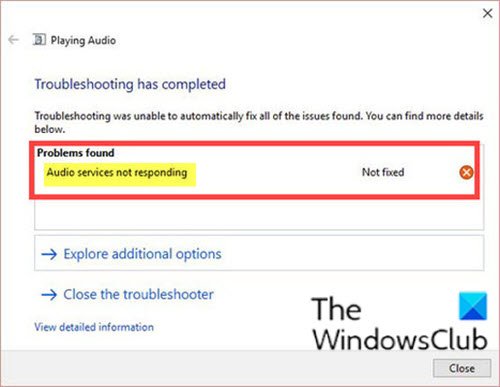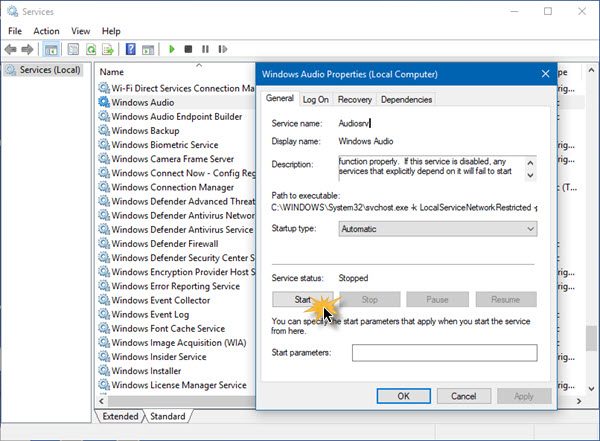The error Audio services not responding is an error message generated via the Playing Audio Troubleshooter which is usually run when you are experiencing problems with your sound or audio devices. This error usually means that your sound device is in an unresponsive where it isn’t responding to your computer’s commands or messages. In this post, we will identify the possible cause of this issue, as well as provide the appropriate solutions you can try to help you resolve the issue as quickly as possible.
This error message is a very common error and usually occurs when you upgrade your version of Windows 10 via Windows Update. There are a few workarounds which include making sure that all the audio services are running as expected and the drivers are updated to the latest build.

Audio services not responding in Windows 11/10
If you’re faced with this error message Audio services not responding issue, you can try our recommended solutions in the order presented below and see if that helps to resolve the issue.
- Restart Audio Services
- Check audio components
- Run the add networkservice & add localservice commands
- Install default sound drivers
- Install Realtek or High Definition Audio Device
- Run Audio and Sound troubleshooter
- Run the SFC and DISM scan
- Perform System Restore
- Perform a Fresh Start, In-place upgrade repair or Cloud Reset
Let’s take a look at the description of the process involved concerning each of the listed solutions.
Before you jump into any of the solutions, first connect the device to a different USB port. The problem may not occur if the device is connected to a different USB port.
1] Restart Audio services
Alongside your sound hardware and drivers, there is an audio service present which is responsible for managing the audio on your computer. In this solution, a simple restart might reboot its configurations and solve the issue.
If that does not help, you may need to restart the Audio-related Services manually.

Type services.msc in the search bar and hit Enter to open the Windows Services Manager . Scroll down to Windows Audio Service and double-click on it to open its Properties. This Service manages audio for Windows-based programs. If this service is stopped, audio devices and effects will not function properly. If this service is disabled, any services that explicitly depend on it will fail to start
Set the Startup Type to Automatic and click on the Start button. If it already started, Stop it and then Start it again.
You should ensure that its Dependency Services are started and have Automatic Startup type:
- Remote Procedure Call
- Windows Audio Endpoint Builder
If the Multimedia Class Scheduler Service is present on your system, that too should be Started and set on Automatic.
Read: The Audio Service is not running.
2] Check audio components
This solution requires you to make sure that all the audio components are running. If any of them isn’t, it may cause the issue. Also, if you’re running third-party security software on Windows 10, temporarily disable it the program as they sometimes block some critical services like the audio service.
To check audio components, do the following:
Press Windows key + R to invoke the Run dialog.
In the Run dialog box, type services.msc and hit Enter to open Services window.
In the Services window, locate and make sure that the three services below are running. If they are not, right-click on them and click Start.
- RPC Endpoint Mapper
- Remote Procedure Call (RPC)
- DCOM Server Process Launcher
Also, make sure that all these services are set to start as Automatic.
Restart the computer.
On boot, check to see if the issue is resolved. If not, continue with the next solution.
3] Run the add networkservice & add localservice commands
To run the add networkservice & add localservice commands, do the following:
- Press Windows key + R.
- In the Run dialog box, type cmd and then press CTRL + SHIFT + ENTER to open Command Prompt in elevated mode.
- In the command prompt window, copy and paste the command below and hit Enter.
net localgroup Administrators /add networkservice
- Once the command executes, copy and paste this next command and hit Enter.
net localgroup Administrators /add localservice
- Exit CMD prompt and restart your computer.
On boot, check to see if the issue is resolved. If not, continue with the next solution.
4] Install default sound drivers
As Windows operating system keeps upgrading over time, the sound drivers are also included in most of the packages and they also get updated periodically. Windows 10 has a basic default sound driver already saved so whenever you uninstall your current drivers, Windows 11/10 recognizes the hardware connected and installs the driver accordingly.
In this solution, you can try installing the default audio driver on your system and see if that resolves the issue.
Here’s how:
- Press Windows key + R.
- In the Run dialog, type control system and hit Enter to open System window.
- In the System window, click Advanced system settings option at the left side of the screen.
- Now, click the Hardware tab.
- Click on Device Installation Settings.
- Select the radio button for No (your device might not work as expected) option.
- Click Save changes and exit. This will disable the Windows update from updating your audio drivers automatically.
Note: If this solution doesn’t work, make sure to change the option back to Yes.
- Next, press Windows key + X to open the Power User Menu.
- Tap M on the keyboard to open Device Manager.
- In the Device Manager, expand the Sound, video, and game controllers category.
- Right-click on your sound device and select Uninstall device.
- Check the uninstall driver checkbox to uninstall the driver as well and proceed with the uninstallation.
- Once the device is uninstalled, right-click on any space on the Device Manager and select Scan for hardware changes.
- Reboot your computer.
Your computer will now detect the audio hardware on your computer and automatically install the default drivers present on your computer.
If the issue persists, continue with the next solution.
Read: One or more audio service isn’t running.
5] Install Realtek or High Definition Audio Device
Some users reported that they were able to solve the issue by installing High Definition Audio Device driver instead of IDT High Definition Audio CODEC.
To install the Realtek or High Definition Audio Device driver, do the following:
- Open Device Managercontrol panel applet
- In the Device Manager, expand the Sound, video, and game controllers category.
- Right-click on your sound device and select Update Driver.
- On the How do you want o search for drivers? dialog, select Browse my computer for driver software.
- Now select Let me pick from a list of available drivers on my computer.
- Uncheck the Show compatible hardware option to ensure that all the results are listed in your drivers’ list.
- Scroll through all the drivers until you find High Definition Audio Device.
- Select it and click Next.
- Follow the on-screen instructions to complete the installation.
- Restart your computer.
On boot, check to see if the issue is resolved. If not, continue with the next solution.
Note: If this doesn’t work, try downloading the audio drivers from the device manufacturer’s website and install it. In most cases, this also solved the problem.
6] Run Audio troubleshooter
Run the Audio or Sound troubleshooter. Windows 10 already includes Playing Audio Troubleshooter and Recording Audio Troubleshooter, which you can easily invoke via the Control Panel, the Taskbar Search or the Troubleshooters tab of our freeware FixWin. You can also access the Troubleshooters Page in Windows 11/10.
7] Run the SFC and DISM scan
If you have system file errors, you may encounter the Audio services not responding issue. In which case, you can run the SFC/DISM scan – a utility in Windows 10 that allows users to scan for corruptions in Windows system files and restore corrupted files.
After the scan and the issue is unresolved, continue with the next solution.
8] Perform System Restore
If you have no idea what changed that might have ended up breaking the audio service, you can perform System Restore (any changes like application install, user preferences, and anything else made after the restore point will be lost) to revert to date before when you started encountering the Audio services not responding issue
9] Perform a Fresh Start, In-place upgrade repair or Cloud Reset
At this point, if the Audio services not responding issue is still unresolved, it’s most likely due to some kind of system corruption that cannot be resolved conventionally. In this case, you can try Fresh Start, In-place upgrade repair to reset every Windows component. Also, you can try Cloud Reset and see if that helps.
Hopefully, any of these solutions will work for you!
Leave a Reply